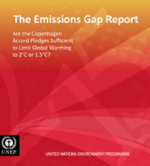 23 November 2010: The UN Environment Programme (UNEP), the European Climate Foundation and the National Institute of Ecology-SEMARNAT, Mexico, have launched a report titled “The Emissions Gap Report,” in advance of the Cancun Climate Change Conference.
23 November 2010: The UN Environment Programme (UNEP), the European Climate Foundation and the National Institute of Ecology-SEMARNAT, Mexico, have launched a report titled “The Emissions Gap Report,” in advance of the Cancun Climate Change Conference.
The report spotlights the size of the ’emissions gap’ between where countries might be in 2020 versus where the science indicates they need to be. According to the report, countries have the chance to reduce emissions to 49 gigatons of carbon dioxide equivalent by 2020, 60% of the reductions needed to keep global temperatures under a 2ºC rise, if Copenhagen Accord pledges are fully met. This would leave a gap of around five gigatons of carbon dioxide equivalent to be bridged over the next decade.
Other key findings of the report include that: under a business-as-usual scenario, annual emissions of greenhouse gases (GHGs) could be around 56 gigatons of carbon dioxide equivalent by 2020; and in the worst case identified in the report – where countries follow their lowest ambitions and accounting rules set by negotiators are lax rather than strict – emissions could be as high as 53 gigatons in 2020, only slightly lower than business as usual projections.
Reflecting on the results of the report, Juan Rafael Elvira, Mexican Secretary of Environment and Natural Resources, stated that “the level of effort expressed in the Copenhagen Accord in terms of emission reduction is almost three times higher than what was achieved with the Kyoto Protocol.” He underscored the “need to formalize and, if possible, increase current pledges and translate them into commitments for developed countries and into acknowledged actions for developing countries.” [UNEP Press Release] [Emissions Gap Report]
